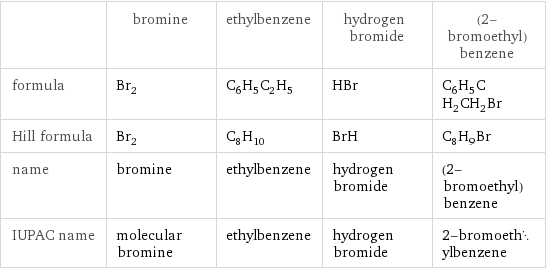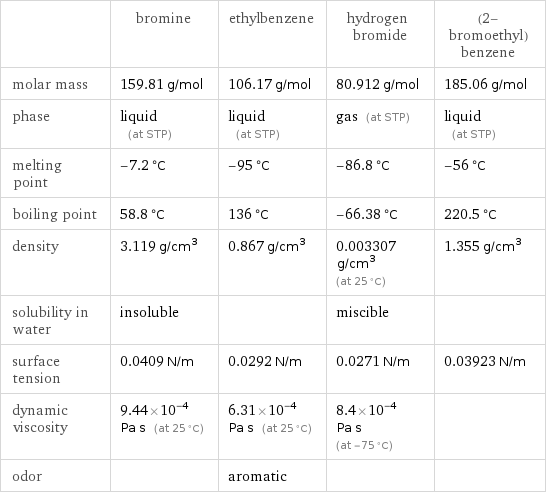Input interpretation

Br_2 bromine + C_6H_5C_2H_5 ethylbenzene ⟶ HBr hydrogen bromide + C_6H_5CH_2CH_2Br (2-bromoethyl)benzene
Balanced equation

Balance the chemical equation algebraically: Br_2 + C_6H_5C_2H_5 ⟶ HBr + C_6H_5CH_2CH_2Br Add stoichiometric coefficients, c_i, to the reactants and products: c_1 Br_2 + c_2 C_6H_5C_2H_5 ⟶ c_3 HBr + c_4 C_6H_5CH_2CH_2Br Set the number of atoms in the reactants equal to the number of atoms in the products for Br, C and H: Br: | 2 c_1 = c_3 + c_4 C: | 8 c_2 = 8 c_4 H: | 10 c_2 = c_3 + 9 c_4 Since the coefficients are relative quantities and underdetermined, choose a coefficient to set arbitrarily. To keep the coefficients small, the arbitrary value is ordinarily one. For instance, set c_1 = 1 and solve the system of equations for the remaining coefficients: c_1 = 1 c_2 = 1 c_3 = 1 c_4 = 1 Substitute the coefficients into the chemical reaction to obtain the balanced equation: Answer: | | Br_2 + C_6H_5C_2H_5 ⟶ HBr + C_6H_5CH_2CH_2Br
Structures

+ ⟶ +
Names

bromine + ethylbenzene ⟶ hydrogen bromide + (2-bromoethyl)benzene
Equilibrium constant
![Construct the equilibrium constant, K, expression for: Br_2 + C_6H_5C_2H_5 ⟶ HBr + C_6H_5CH_2CH_2Br Plan: • Balance the chemical equation. • Determine the stoichiometric numbers. • Assemble the activity expression for each chemical species. • Use the activity expressions to build the equilibrium constant expression. Write the balanced chemical equation: Br_2 + C_6H_5C_2H_5 ⟶ HBr + C_6H_5CH_2CH_2Br Assign stoichiometric numbers, ν_i, using the stoichiometric coefficients, c_i, from the balanced chemical equation in the following manner: ν_i = -c_i for reactants and ν_i = c_i for products: chemical species | c_i | ν_i Br_2 | 1 | -1 C_6H_5C_2H_5 | 1 | -1 HBr | 1 | 1 C_6H_5CH_2CH_2Br | 1 | 1 Assemble the activity expressions accounting for the state of matter and ν_i: chemical species | c_i | ν_i | activity expression Br_2 | 1 | -1 | ([Br2])^(-1) C_6H_5C_2H_5 | 1 | -1 | ([C6H5C2H5])^(-1) HBr | 1 | 1 | [HBr] C_6H_5CH_2CH_2Br | 1 | 1 | [C6H5CH2CH2Br] The equilibrium constant symbol in the concentration basis is: K_c Mulitply the activity expressions to arrive at the K_c expression: Answer: | | K_c = ([Br2])^(-1) ([C6H5C2H5])^(-1) [HBr] [C6H5CH2CH2Br] = ([HBr] [C6H5CH2CH2Br])/([Br2] [C6H5C2H5])](../image_source/584dc631633c4e7db475838555116c29.png)
Construct the equilibrium constant, K, expression for: Br_2 + C_6H_5C_2H_5 ⟶ HBr + C_6H_5CH_2CH_2Br Plan: • Balance the chemical equation. • Determine the stoichiometric numbers. • Assemble the activity expression for each chemical species. • Use the activity expressions to build the equilibrium constant expression. Write the balanced chemical equation: Br_2 + C_6H_5C_2H_5 ⟶ HBr + C_6H_5CH_2CH_2Br Assign stoichiometric numbers, ν_i, using the stoichiometric coefficients, c_i, from the balanced chemical equation in the following manner: ν_i = -c_i for reactants and ν_i = c_i for products: chemical species | c_i | ν_i Br_2 | 1 | -1 C_6H_5C_2H_5 | 1 | -1 HBr | 1 | 1 C_6H_5CH_2CH_2Br | 1 | 1 Assemble the activity expressions accounting for the state of matter and ν_i: chemical species | c_i | ν_i | activity expression Br_2 | 1 | -1 | ([Br2])^(-1) C_6H_5C_2H_5 | 1 | -1 | ([C6H5C2H5])^(-1) HBr | 1 | 1 | [HBr] C_6H_5CH_2CH_2Br | 1 | 1 | [C6H5CH2CH2Br] The equilibrium constant symbol in the concentration basis is: K_c Mulitply the activity expressions to arrive at the K_c expression: Answer: | | K_c = ([Br2])^(-1) ([C6H5C2H5])^(-1) [HBr] [C6H5CH2CH2Br] = ([HBr] [C6H5CH2CH2Br])/([Br2] [C6H5C2H5])
Rate of reaction
![Construct the rate of reaction expression for: Br_2 + C_6H_5C_2H_5 ⟶ HBr + C_6H_5CH_2CH_2Br Plan: • Balance the chemical equation. • Determine the stoichiometric numbers. • Assemble the rate term for each chemical species. • Write the rate of reaction expression. Write the balanced chemical equation: Br_2 + C_6H_5C_2H_5 ⟶ HBr + C_6H_5CH_2CH_2Br Assign stoichiometric numbers, ν_i, using the stoichiometric coefficients, c_i, from the balanced chemical equation in the following manner: ν_i = -c_i for reactants and ν_i = c_i for products: chemical species | c_i | ν_i Br_2 | 1 | -1 C_6H_5C_2H_5 | 1 | -1 HBr | 1 | 1 C_6H_5CH_2CH_2Br | 1 | 1 The rate term for each chemical species, B_i, is 1/ν_i(Δ[B_i])/(Δt) where [B_i] is the amount concentration and t is time: chemical species | c_i | ν_i | rate term Br_2 | 1 | -1 | -(Δ[Br2])/(Δt) C_6H_5C_2H_5 | 1 | -1 | -(Δ[C6H5C2H5])/(Δt) HBr | 1 | 1 | (Δ[HBr])/(Δt) C_6H_5CH_2CH_2Br | 1 | 1 | (Δ[C6H5CH2CH2Br])/(Δt) (for infinitesimal rate of change, replace Δ with d) Set the rate terms equal to each other to arrive at the rate expression: Answer: | | rate = -(Δ[Br2])/(Δt) = -(Δ[C6H5C2H5])/(Δt) = (Δ[HBr])/(Δt) = (Δ[C6H5CH2CH2Br])/(Δt) (assuming constant volume and no accumulation of intermediates or side products)](../image_source/2320caab69df2eede992b899eb2b5dbf.png)
Construct the rate of reaction expression for: Br_2 + C_6H_5C_2H_5 ⟶ HBr + C_6H_5CH_2CH_2Br Plan: • Balance the chemical equation. • Determine the stoichiometric numbers. • Assemble the rate term for each chemical species. • Write the rate of reaction expression. Write the balanced chemical equation: Br_2 + C_6H_5C_2H_5 ⟶ HBr + C_6H_5CH_2CH_2Br Assign stoichiometric numbers, ν_i, using the stoichiometric coefficients, c_i, from the balanced chemical equation in the following manner: ν_i = -c_i for reactants and ν_i = c_i for products: chemical species | c_i | ν_i Br_2 | 1 | -1 C_6H_5C_2H_5 | 1 | -1 HBr | 1 | 1 C_6H_5CH_2CH_2Br | 1 | 1 The rate term for each chemical species, B_i, is 1/ν_i(Δ[B_i])/(Δt) where [B_i] is the amount concentration and t is time: chemical species | c_i | ν_i | rate term Br_2 | 1 | -1 | -(Δ[Br2])/(Δt) C_6H_5C_2H_5 | 1 | -1 | -(Δ[C6H5C2H5])/(Δt) HBr | 1 | 1 | (Δ[HBr])/(Δt) C_6H_5CH_2CH_2Br | 1 | 1 | (Δ[C6H5CH2CH2Br])/(Δt) (for infinitesimal rate of change, replace Δ with d) Set the rate terms equal to each other to arrive at the rate expression: Answer: | | rate = -(Δ[Br2])/(Δt) = -(Δ[C6H5C2H5])/(Δt) = (Δ[HBr])/(Δt) = (Δ[C6H5CH2CH2Br])/(Δt) (assuming constant volume and no accumulation of intermediates or side products)
Chemical names and formulas

| bromine | ethylbenzene | hydrogen bromide | (2-bromoethyl)benzene formula | Br_2 | C_6H_5C_2H_5 | HBr | C_6H_5CH_2CH_2Br Hill formula | Br_2 | C_8H_10 | BrH | C_8H_9Br name | bromine | ethylbenzene | hydrogen bromide | (2-bromoethyl)benzene IUPAC name | molecular bromine | ethylbenzene | hydrogen bromide | 2-bromoethylbenzene
Substance properties

| bromine | ethylbenzene | hydrogen bromide | (2-bromoethyl)benzene molar mass | 159.81 g/mol | 106.17 g/mol | 80.912 g/mol | 185.06 g/mol phase | liquid (at STP) | liquid (at STP) | gas (at STP) | liquid (at STP) melting point | -7.2 °C | -95 °C | -86.8 °C | -56 °C boiling point | 58.8 °C | 136 °C | -66.38 °C | 220.5 °C density | 3.119 g/cm^3 | 0.867 g/cm^3 | 0.003307 g/cm^3 (at 25 °C) | 1.355 g/cm^3 solubility in water | insoluble | | miscible | surface tension | 0.0409 N/m | 0.0292 N/m | 0.0271 N/m | 0.03923 N/m dynamic viscosity | 9.44×10^-4 Pa s (at 25 °C) | 6.31×10^-4 Pa s (at 25 °C) | 8.4×10^-4 Pa s (at -75 °C) | odor | | aromatic | |
Units
